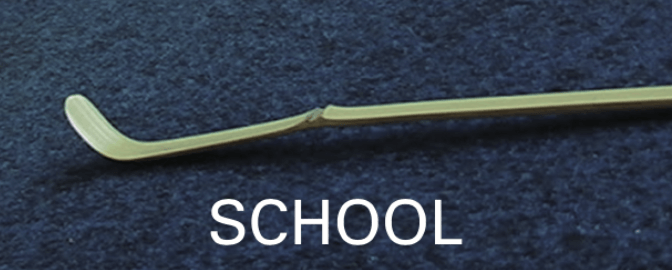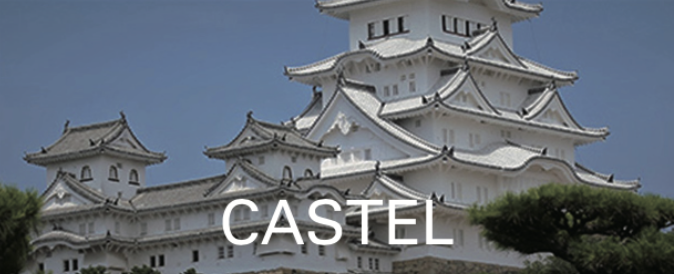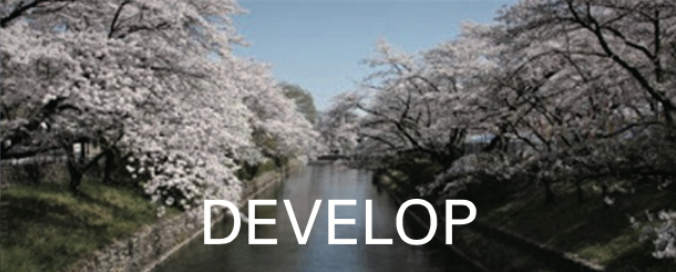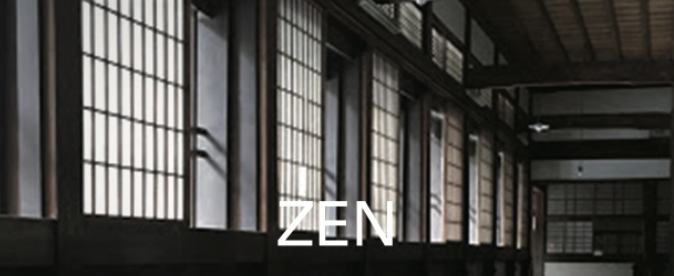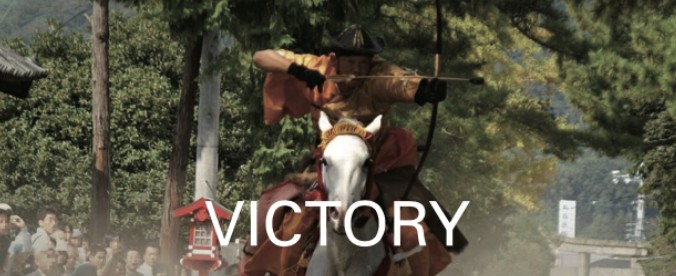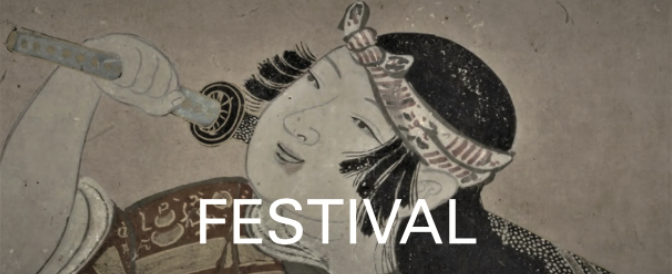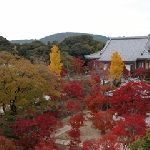
This temple is the head temple of a Buddhist Shingon sect Chisan school, which was a sub-temple of Negorodera Temple in Kishu Wakayama, and prospered as Gakumonojo, prestigious school. Negorodera Temple was burned down by Toyotomi Hideyoshi (1537 – 1598), the powerful feudal lord and Imperial Regent who unified Japan.
Genyu Sojo (1529 – 1605), a Gakuto, scholarly chief of the sect, escaped to Kyoto and revived Chishakuin Temple and became head priest of this temple. Hideyoshi built Shounzenji Temple to perform religious rites for the salvation of the departed soul of his son, Turumatsu, (1589 – 1591).
After some time passed, Tokugawa Ieyasu (1543 – 1616), the founder of the Tokugawa Shogunate, donated the Shounzenji Temple to Sojo. That donation included splendid and elaborate wall paintings, with brightly colored, gold leaves. These were Kaede-zu (Maple Tree painting), and Sakurazu-zu (Cherry Blossom painting) by Hasegawa Tohaku (1539 – 1610): founder of the Hasegawa school, and his son, Hasegawa Kyuzo (1568 – 1593).
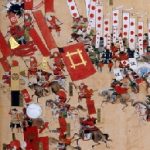
The museum introduces valuable cultural properties and materials transmitted to the Ii family, the lords of Hikone Domain. Hikone Byoubu, Hikone folding screen, is a masterpiece of the early modern genre of Fuzokuzu, the painting of manners and customs, at the beginning of early modern time.
It is presumed that it was produced in the Kanei era(1624~44) in the Edo period and that the motif was the Yuri, the red light district in Kyoto at that time. Each person was drawn to show the intimate relationship, by posing with mountain folds and valley folds of the folding screen form. That composition was well calculated. The line drawings and colors of the hair stitches and costume patterns were extremely refined.
The picture-in-picture resembled Kinkishoga, the Four Elegant Pastimes, (Harp, Chess, Calligraphy and Painting) in Kanga, Chinese style painting.
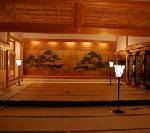
Sasayamajo Castle, was built on the important position of Sanindo, the northwest region of Honshu Island and the main road running through it. It was built by Tokugawa Ieyasu (1543 – 1616), the founder of the Tokugawa Shogunate. Daishoin, a large drawing room of this castle used to be comparable in size and decoration to the Kyoto Nijojo Castle in Kyoto capital, the large drawing room in the great hall of Ninomaru Palace, which was built around the same time.
In Daishoin, restored in 2000, a painting on a folding screen drawn by a painter of the Kanou School is used as a wall painting and reproduces the time and space. Daishoin was a drawing room and represented Kuroshoin, private residential quarters, Shiroshoin, the drawing room of Edojo Castle of Shogun in Tokyo.
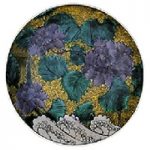
The Aode style of Kutani Pottery uses a deep green and yellow as basic colors, adding bitumen and purple. Both the front and back of the Pottery are hand painted. It encourages drawing with an open-mind and audacious touch.
This museum is located in Kokutani no mori, the Daishoji Fureai Park in Kaga City, and introduces its works by style, including Aode style, Iroe Gosaide, and Akae Kinrande.
There are presentations about techniques of the traditional Kutani style, which used to be made in Kutani Village of Daishoji Domain during the Edo period (1603 – 1868).
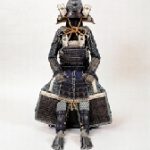
This museum conveys the history of the last completed castle in the Edo period (1603 – 1868) and Daimyo, Japanese feudal lords Culture, in the early modern times. It possesses old drawings, a small dining table with the family crest, bowls and Fushimi Palace sliding screen board painting.
This museum also introduces the primeval and ancient history of Fukuyama, and exhibits clay ware from the Jomon period (16,000 years ago – 3,000 years ago) and the Yayoi period (the 4th BC – 3rd century), stoneware, bronze swords, Haniwa, clay images from the Tumulus period (the 3rd– 7th century), gems, old roof-tiles, and Sue ware, unglazed vessel, earthenware.
This museum also introduces the history of Fukuyama as an important place of the Seto Inland Seaway, through which the civilization and culture from the China continent and the Korean peninsula, had advanced to the east.

—This museum is currently closed due to renovation work, and is scheduled to be reopened in about the fall of 2022.
This museum exhibits the cultural heritage of Okayama Prefecture from the primitive and ancient times to the modern era in an easy-to-understand manner. Kibi Province Okayama had advanced their culture since ancient times, along with Northern Kyushu region and Kinai region, provinces surrounding Kyoto and Nara.
The history of swordsmith had been handed over along the Yoshii River, which used to transport Tamahagane, steel made from iron sand, and wood for fire, to make the swords.
Osafune school in Bizen had produced many famous swords since the Kamakura period (1185 – 1333), and samurai had longed for them, due to their long length and forging.
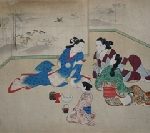
Miyagawa Choshun(1682-1752), the Japanese painter, drew charming and dignified women in his original paintings. He specialized in silk painting and did not paint woodblock print, by supported by influential people. He adored Hikawa Moronobu (1618 – 1694) a Japanese artist of the ukiyo-e genre of woodblock prints. He drew a dignified beauty who did not lose the stability of verticality even if she leaned up while standing.
The museum possesses the incisive masterpieces of the Hachisuka family, who survived the war, and the collection of folk-like paintings of beautiful spots in Edo by Miyagawa Isho (1689 -1780), Japanese painter, who was a disciple of Choshun.

This museum which was built the site of the Akizuki clan school, Keikokan, which gave scholarly lectures and the martial arts, took over the collection of the Akizuki Folk Museum and opened in 2017. The balance of this collection between the Japanese and Western collections is excellent, and the exhibition is surrounded by the beauty of insight.
The collection of about 100 items, consists of feudal lord’s favorite helmet, armor, famous sword, battle surcoat, horse armor, folding screen, and Akizuki historic documents, books, portraits, and others.
This museum also has works of Pierre-Auguste Renoir (1841 – 1919), Marc Chagall (1887 – 1985), Yokoyama Taikan (1868 – 1958), Kawai Gyokudo (1873 – 1957),and Uemura Shoen (1875 – 1949), which were donated by Toki clan from Akizuki.

This museum located in Tenjin, the central area of Fukuoka City, introduces painting materials of the Ogata family. Goyo-eshi, a purveying painter to the Fukuoka Domain, and Yoshimura Tadao (1898 – 1952), a Japanese painter, who learned from Matsuoka Eikyu (1881 – 1938), painted in the style of Yamato-e, and the works of Yamato-e, to express high realism and decorativeness, with subdued color and a depth of taste.
This museum possesses arts associated with Fukuoka Prefecture, like Kurume Kasuri, cotton cloth with splashed patterns, and antique porcelains from the Kyushu area. And the art scene of Fukuoka’s “now” is also introduced.
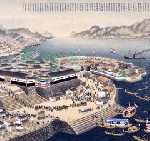
This castle is the castle of Nabeshima clan of Saga Domain. The Saga Castle History Museum, which has faithfully restored part of the palace of Honmaru, the keep of a castle, is now built on the site of Saga Castle. A 45m long hallway with tatami-matted floors and a large hall with 320 tatami mat salon convey the dignity and formality of the palace of Honmaru.
This museum introduces the sprits of the Nabeshima clan with the clan kiln of Nabeshima ware, to create traditional beauty of style and the passion of the Nabeshima clan. The painting of Nagasaki Naval Training established in 1855, tells the history of the End of the Edo period, in the 19th century, to explore the civilization from abroad.
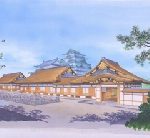
Nagoya in Hizen Province, Saga was the base of the Bunroku-Keicho War (1592 – 1598), the Japanese invasion of Korea. Nagoyajo Castle was built as the abode of Toyotomi Hideyoshi (1537 – 1598), the powerful feudal lord and Imperial Regent who unified Japan. Toyotomi built encampments for feudal lords all over Japan to participate in the war. Momoyama culture, whose splendid style began in Kyoto, started to spread all over Japan from here. This museum introduces its history.
This museum possesses the folding screen painted by, Kanou Mitsunobu (1565 – 1608), the eldest son of Kanou Eitoku, (1543 – 1590), one of the most influential Japanese painters, and a head of the Kanou school of Japanese painting. Kanou Eitoku painted in magnificent style. Kanou Mitsunobu painted delicate, elegant and gentle lightness to express the profoundness of the subject, even when criticizing himself, in comparison to his father.
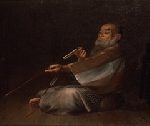
This museum was opened in 1983 on the site of Sagajo Castle, third bailey, for the 100th anniversary of the prefectural government.
This museum possesses many masterpieces of artists from Saga. This museum exhibits Modern Western paintings of Hyakutake Kaneyuki (1842 – 1884) a diplomat and a Japanese painter, who studied painting in France, Kume Keiichiro (1866 – 1934), a Japanese painter, who learned from French painter Raphael Collin, Okada Saburosuke (1869 – 1939), a Japanese painter, sculptures by Koga Tadao (1903 – 1979), a Japanese modern and contemporary sculptor, calligraphy of Nakabayashi Gochiku (1827 – 1913), one of the best Japanese calligraphers in the Meiji period (1868 – 1912), Soejima Taneomi Sokai (1828 – 1905), a diplomat, Japanese calligraphers, and others.
Above all, you should see Hizen-to, the sword of Hisen Province, Saga, founded by Dadayoshi (1572 – 1632), the originator of Hizen-to. Dadayoshi was the master of Hizen Shito, a new sword from Hizen Province. Hizen-to fully conveys the Nabeshima clan‘s intelligence about beauty, as these swords do not lose their color.
